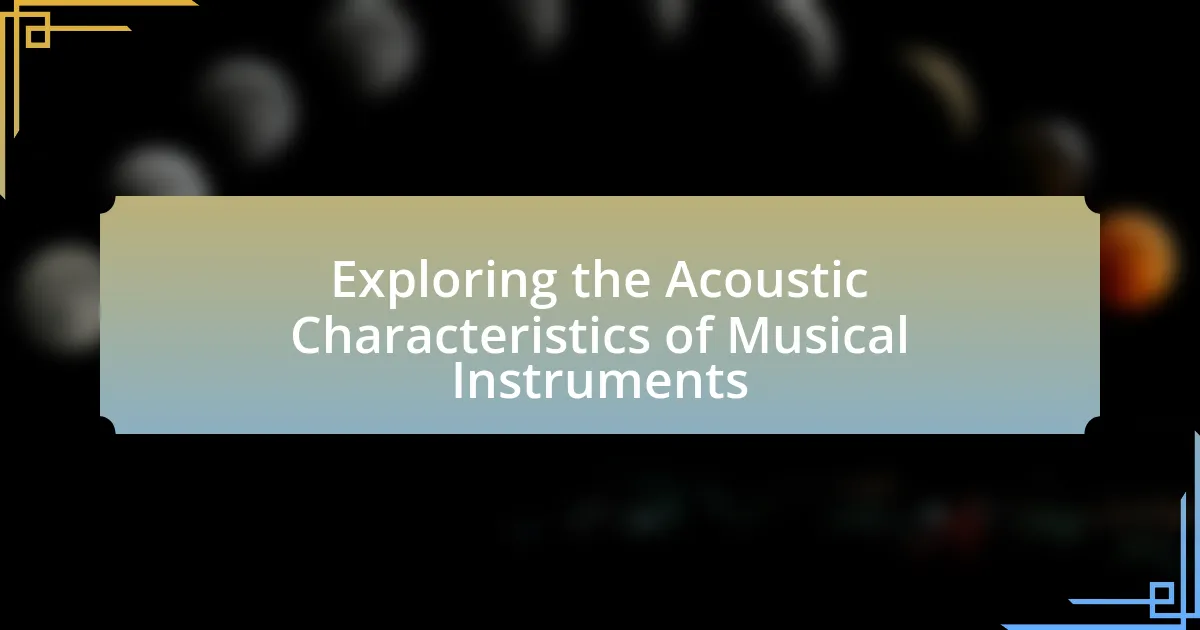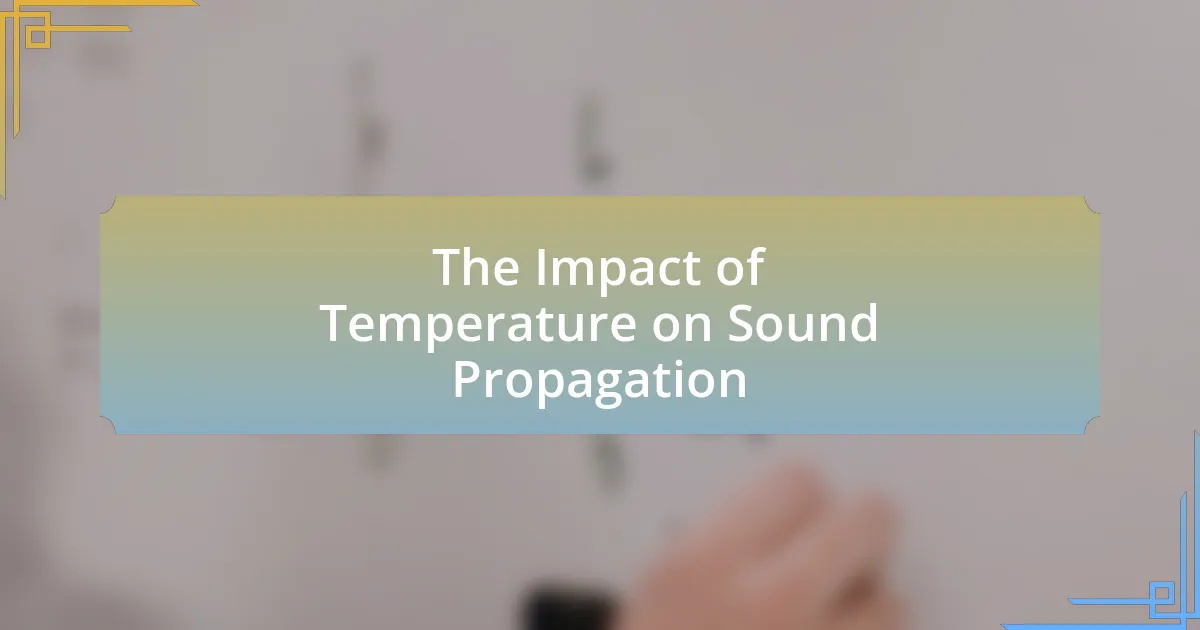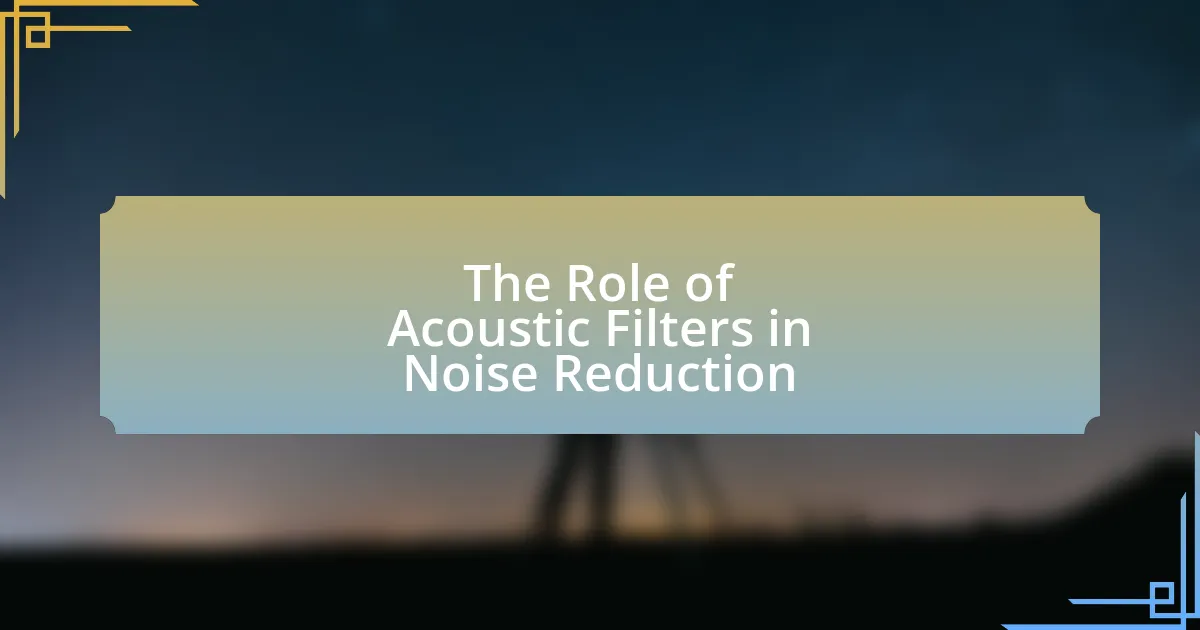The article focuses on the effect of ocean waves on underwater sound propagation, detailing how waves influence sound speed, scattering, and transmission loss in marine environments. It explains that ocean waves alter pressure and temperature, leading to variations in sound speed and creating phenomena such as surface ducting. The article also discusses the implications of these changes for marine life, including communication disruptions among species and habitat alterations. Additionally, it highlights the methods used to study sound propagation, the challenges faced in research, and the practical applications of understanding sound behavior in relation to ocean waves.
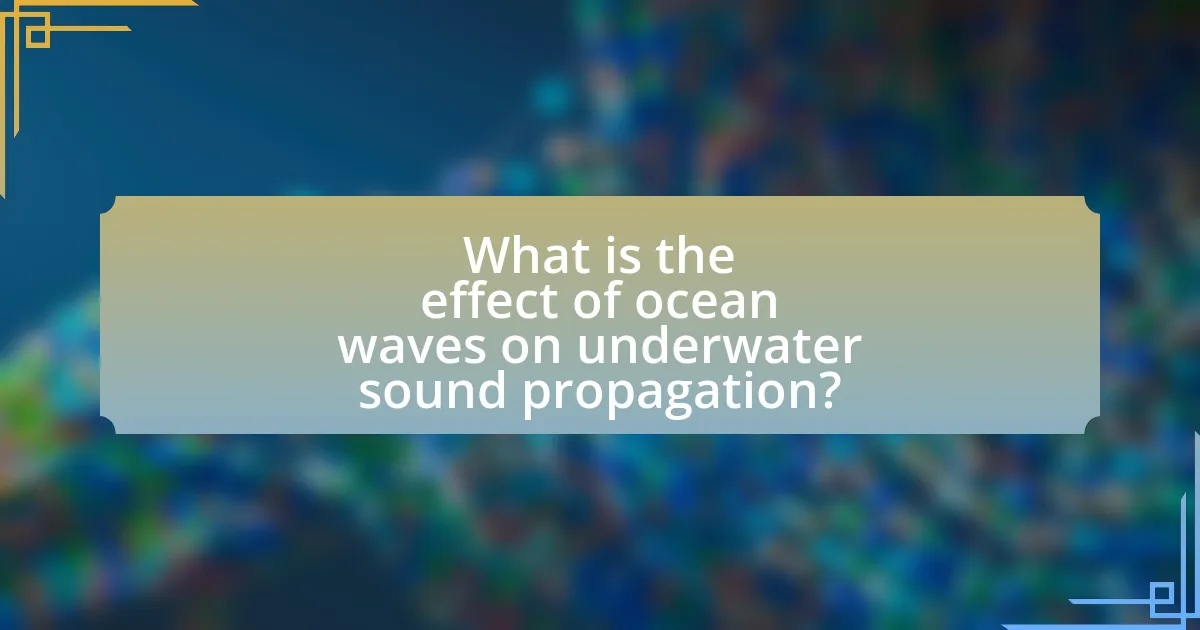
What is the effect of ocean waves on underwater sound propagation?
Ocean waves significantly affect underwater sound propagation by altering the sound speed and creating varying pressure conditions. The movement of waves generates turbulence and changes the density of water, which can lead to refraction of sound waves. Research indicates that sound travels faster in warmer water, and the mixing caused by waves can create layers of different temperatures and salinities, further influencing sound speed. Additionally, surface waves can create a phenomenon known as “surface ducting,” where sound waves are trapped near the surface, enhancing their propagation over long distances.
How do ocean waves influence sound speed in water?
Ocean waves influence sound speed in water primarily through changes in pressure and temperature. As waves propagate, they create variations in water density and temperature, which directly affect sound speed. Specifically, sound travels faster in warmer water and slower in colder water; thus, the movement of waves can lead to localized temperature changes that alter sound propagation. Research indicates that sound speed increases by approximately 4.0 meters per second for every 1°C rise in temperature, demonstrating the significant impact of thermal dynamics caused by ocean waves on sound speed.
What factors affect sound speed in relation to wave activity?
Sound speed in relation to wave activity is primarily affected by water temperature, salinity, and pressure. Higher temperatures increase sound speed due to the enhanced kinetic energy of water molecules, while increased salinity raises sound speed by altering the density and compressibility of seawater. Additionally, greater pressure, which occurs with increased water depth, also contributes to higher sound speed as it compresses the water, making it denser. These factors are critical in underwater acoustics, as they influence how sound waves propagate through the ocean, impacting sonar and marine communication systems.
How does temperature variation impact sound speed during wave events?
Temperature variation significantly impacts sound speed during wave events, as sound travels faster in warmer water. Specifically, an increase in temperature by 1 degree Celsius can increase sound speed by approximately 4.0 to 4.5 meters per second. This phenomenon occurs because higher temperatures reduce water density and increase the energy of sound waves, facilitating quicker propagation. Studies, such as those conducted by the Office of Naval Research, have demonstrated that temperature gradients in the ocean can create layers of varying sound speeds, affecting how sound waves travel over long distances.
What role do ocean waves play in sound scattering?
Ocean waves significantly influence sound scattering by creating a dynamic surface that alters the propagation paths of sound waves. The movement and turbulence generated by waves cause variations in pressure and density in the water, which leads to scattering of sound energy in multiple directions. Research indicates that the scattering effects are particularly pronounced at higher frequencies, where the interaction with the wave surface can redirect sound waves away from their original trajectory. This phenomenon is critical in underwater acoustics, as it affects the clarity and range of sound transmission, impacting marine communication and sonar operations.
How do wave patterns affect the scattering of sound waves?
Wave patterns significantly influence the scattering of sound waves by altering the medium through which the sound travels. As ocean waves create varying pressure and density distributions in the water, they lead to changes in the acoustic properties of the environment. This results in sound waves being redirected, refracted, or reflected, depending on the wave pattern’s characteristics, such as amplitude and frequency. Research indicates that irregular wave patterns can enhance scattering effects, causing sound waves to disperse over larger areas, which can impact underwater communication and marine life interactions.
What is the significance of scattering in underwater acoustics?
Scattering in underwater acoustics is significant because it affects sound propagation by altering the direction and intensity of sound waves as they encounter various underwater objects and structures. This phenomenon is crucial for understanding how sound travels in the ocean, as scattering can lead to changes in signal strength and clarity, impacting sonar performance and marine communication. Studies have shown that scattering can be influenced by factors such as the size, shape, and distribution of marine organisms, as well as the seabed characteristics, which can all contribute to the complexity of underwater sound fields.
How do ocean waves impact sound transmission loss?
Ocean waves significantly impact sound transmission loss by altering the acoustic environment through changes in pressure, temperature, and salinity. As waves propagate, they create turbulence and surface motion, which can scatter sound waves and increase attenuation. Research indicates that sound speed varies with wave height and frequency, affecting how sound travels underwater. For instance, studies have shown that higher wave activity can lead to greater sound scattering, resulting in increased transmission loss, particularly for low-frequency sounds, which are more susceptible to these effects.
What are the primary causes of sound transmission loss in wave conditions?
The primary causes of sound transmission loss in wave conditions include scattering, absorption, and refraction. Scattering occurs when sound waves encounter irregularities in the medium, such as bubbles or turbulence created by waves, which disrupts the sound path. Absorption refers to the conversion of sound energy into heat due to the medium’s properties, with higher frequencies experiencing greater loss. Refraction happens when sound waves travel through layers of water with varying temperatures and salinities, causing the waves to bend and potentially lose energy. These factors collectively contribute to the degradation of sound transmission in marine environments, impacting underwater communication and sonar operations.
How does transmission loss vary with different wave heights?
Transmission loss increases with higher wave heights due to enhanced surface turbulence and scattering effects. As wave heights rise, the energy of the waves creates more complex surface conditions, which disrupts the propagation of sound waves underwater. Research indicates that significant wave heights can lead to increased attenuation of sound, with studies showing that transmission loss can increase by approximately 3 to 6 decibels for every meter of wave height increase. This relationship is critical in understanding sound propagation in marine environments, particularly for applications such as underwater communication and marine biology studies.
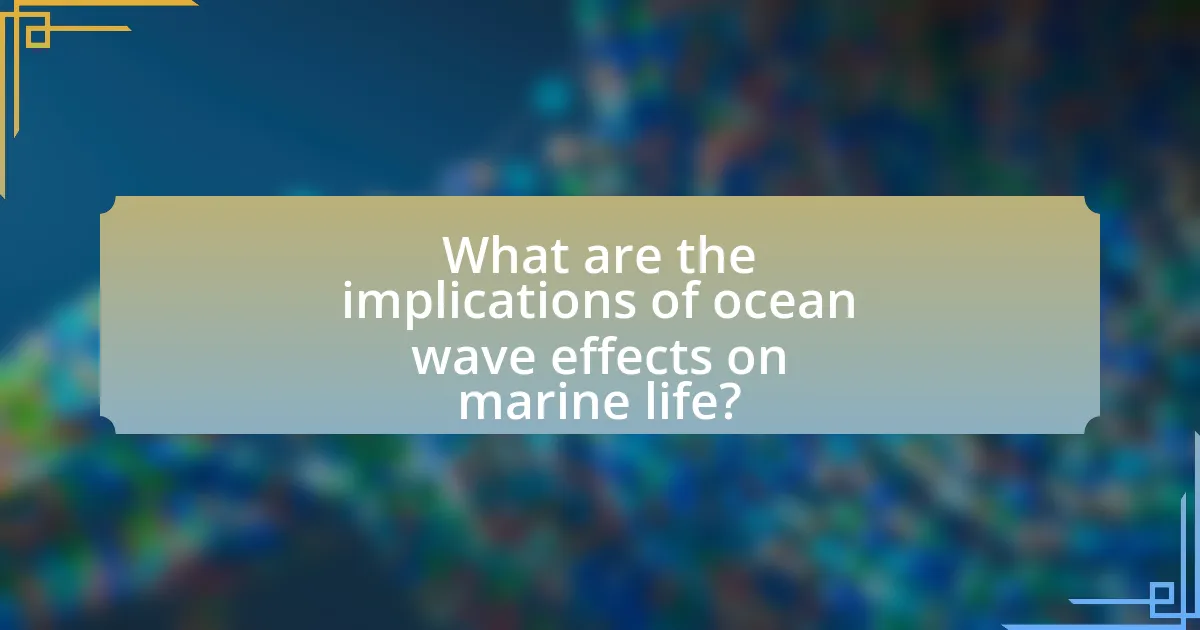
What are the implications of ocean wave effects on marine life?
Ocean wave effects significantly impact marine life by altering habitats, influencing feeding behaviors, and affecting communication among species. The turbulence created by waves can resuspend sediments, which may smother benthic organisms and disrupt the feeding patterns of filter feeders. Additionally, the sound generated by waves can interfere with the acoustic communication of marine animals, such as whales and dolphins, which rely on sound for navigation and social interactions. Research indicates that increased wave activity can lead to changes in species distribution and abundance, as organisms adapt to shifting environmental conditions. For instance, studies have shown that areas with higher wave energy often support different assemblages of marine species compared to calmer regions, highlighting the direct relationship between wave dynamics and marine biodiversity.
How do changes in sound propagation affect marine species communication?
Changes in sound propagation significantly affect marine species communication by altering the transmission and reception of acoustic signals. Variations in water temperature, salinity, and pressure can modify sound speed and attenuation, impacting how far and clearly sounds travel underwater. For instance, studies have shown that increased ocean noise from human activities can mask important biological sounds, such as mating calls or distress signals, leading to reduced communication effectiveness among species like whales and dolphins. This disruption can affect social structures, mating success, and predator-prey interactions, ultimately influencing population dynamics and ecosystem health.
What specific marine species are most affected by sound changes?
Marine species most affected by sound changes include cetaceans, such as whales and dolphins, as well as fish species like cod and herring. Cetaceans rely heavily on echolocation and communication through sound, making them particularly vulnerable to noise pollution and changes in underwater acoustics. Research indicates that increased noise levels can disrupt their communication, navigation, and feeding behaviors. For instance, a study published in the journal “Marine Pollution Bulletin” by Hildebrand (2004) highlights that anthropogenic noise can interfere with the acoustic signals used by these species, leading to potential declines in their populations. Fish species, such as cod and herring, also depend on sound for mating and predator avoidance, and changes in sound propagation can affect their reproductive success and survival rates.
How does sound interference from waves impact predator-prey interactions?
Sound interference from waves significantly disrupts predator-prey interactions by masking critical acoustic signals used for communication and detection. Predators rely on sound to locate prey, while prey use sound to detect predators. When ocean waves create noise, it can obscure these vital sounds, leading to decreased hunting success for predators and increased vulnerability for prey. Research indicates that in environments with high wave activity, such as coastal areas, the effectiveness of echolocation in predators like dolphins is reduced, impacting their ability to hunt effectively. This interference can lead to shifts in prey behavior, as they may not hear approaching threats, ultimately affecting the dynamics of the ecosystem.
What are the consequences for underwater ecosystems?
The consequences for underwater ecosystems include habitat degradation, altered species behavior, and disrupted food webs. Ocean waves can lead to increased sediment resuspension, which smothers coral reefs and seagrass beds, essential habitats for many marine species. Additionally, the sound generated by waves can interfere with the communication and navigation of marine animals, such as whales and dolphins, which rely on echolocation. Research indicates that noise pollution from wave action can lead to stress responses in marine life, affecting reproduction and survival rates. For instance, a study published in the journal “Marine Ecology Progress Series” found that increased underwater noise levels can significantly impact fish populations, altering their foraging and mating behaviors.
How does altered sound propagation influence habitat use by marine animals?
Altered sound propagation significantly influences habitat use by marine animals by affecting their communication, navigation, and predator-prey interactions. Changes in sound transmission due to ocean waves can disrupt the acoustic environment, leading to difficulties in locating mates, finding food, and avoiding predators. For instance, studies have shown that increased background noise from human activities can mask important biological sounds, such as the calls of whales, which are crucial for mating and social interactions. Additionally, marine species like fish rely on sound for navigation; alterations in sound propagation can lead to habitat displacement or changes in migratory patterns. Research indicates that species such as the Atlantic cod have shown altered distribution patterns in response to increased noise levels, demonstrating the direct impact of sound changes on their habitat use.
What role does sound play in the overall health of marine ecosystems?
Sound plays a crucial role in the overall health of marine ecosystems by facilitating communication, navigation, and predator-prey interactions among marine species. Many marine animals, such as whales and dolphins, rely on sound for long-distance communication and social bonding, which are essential for their survival and reproduction. Additionally, sound helps species locate food and avoid predators, thereby maintaining the balance of marine food webs. Research indicates that anthropogenic noise pollution can disrupt these natural soundscapes, leading to stress and altered behaviors in marine life, which can ultimately affect population dynamics and ecosystem health. For instance, a study published in the journal “Marine Pollution Bulletin” highlights that increased noise levels can interfere with the acoustic signals used by fish for mating and navigation, demonstrating the direct impact of sound on marine biodiversity.
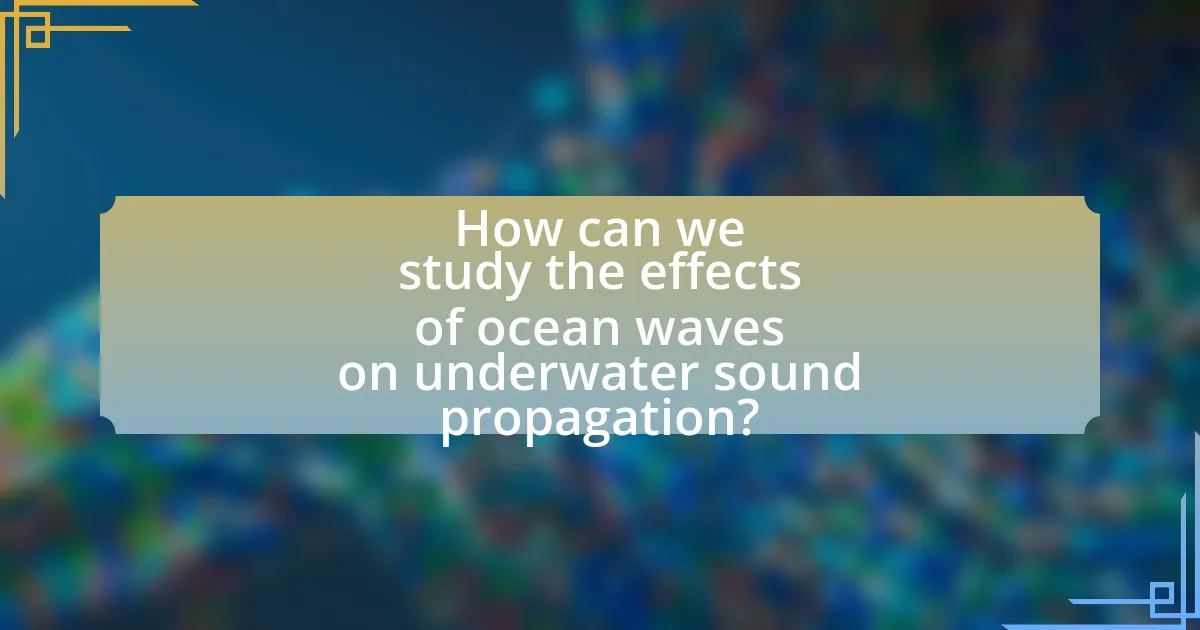
How can we study the effects of ocean waves on underwater sound propagation?
To study the effects of ocean waves on underwater sound propagation, researchers can utilize a combination of field experiments, numerical modeling, and laboratory simulations. Field experiments involve deploying underwater microphones (hydrophones) in various wave conditions to measure sound transmission and scattering. Numerical modeling employs mathematical algorithms to simulate sound wave behavior in different ocean wave scenarios, allowing for predictions of sound propagation under varying conditions. Laboratory simulations can replicate ocean wave effects in controlled environments, providing insights into sound interactions with wave dynamics. These methods collectively enhance understanding of how ocean waves influence sound propagation, supported by studies such as “Sound Propagation in the Ocean: A Review” published in the Journal of Acoustical Society of America, which highlights the significance of wave-induced changes in sound speed and direction.
What methods are used to measure sound propagation in ocean environments?
Methods used to measure sound propagation in ocean environments include underwater acoustic sensors, hydrophones, and sonar systems. Underwater acoustic sensors capture sound waves and analyze their characteristics, while hydrophones convert sound waves into electrical signals for further analysis. Sonar systems, which can be active or passive, utilize sound propagation to detect objects and map underwater terrain. These methods are validated by their widespread application in marine research, naval operations, and environmental monitoring, demonstrating their effectiveness in understanding sound behavior in oceanic conditions.
How do researchers utilize hydrophones to study sound in relation to waves?
Researchers utilize hydrophones to study sound in relation to waves by deploying these underwater microphones to capture acoustic signals generated by wave interactions. Hydrophones are sensitive to variations in pressure and can detect sound waves produced by phenomena such as breaking waves, underwater currents, and marine life. For instance, studies have shown that hydrophones can record the sound of waves breaking on the shore, which provides insights into wave energy and its impact on sound propagation. This data helps researchers understand how sound travels through different water conditions, influenced by factors like wave height and frequency, thereby contributing to the broader understanding of underwater acoustics and marine environments.
What technologies are emerging for better sound measurement in oceans?
Emerging technologies for better sound measurement in oceans include autonomous underwater vehicles (AUVs), advanced hydrophone arrays, and machine learning algorithms for data analysis. AUVs equipped with sophisticated sensors can collect high-resolution acoustic data over large areas, enhancing spatial and temporal resolution in sound measurement. Advanced hydrophone arrays allow for precise localization and characterization of underwater sounds, improving the understanding of sound propagation in relation to ocean wave dynamics. Machine learning algorithms analyze vast datasets, identifying patterns and anomalies in sound data, which aids in understanding the effects of ocean waves on sound propagation. These technologies collectively enhance the accuracy and efficiency of underwater sound measurement, contributing to marine research and environmental monitoring.
What are the challenges in studying sound propagation affected by ocean waves?
Studying sound propagation affected by ocean waves presents several challenges, primarily due to the dynamic and complex nature of the ocean environment. Variability in wave patterns, which can change rapidly, complicates the prediction of sound behavior. Additionally, factors such as temperature gradients, salinity variations, and ocean currents further influence sound speed and direction, making it difficult to establish consistent models. Research indicates that the interaction between sound waves and surface waves can lead to scattering and refraction, which adds layers of complexity to data interpretation. Furthermore, the presence of background noise from both natural and anthropogenic sources can obscure sound signals, complicating the analysis of sound propagation in marine settings.
How do environmental factors complicate sound measurement efforts?
Environmental factors complicate sound measurement efforts by introducing variables such as temperature, salinity, and ocean currents that affect sound speed and propagation. For instance, variations in water temperature can change sound speed by approximately 4.0 meters per second for every 1°C change, leading to inaccuracies in distance measurements. Additionally, salinity levels can alter sound absorption rates, while ocean currents can create Doppler shifts, further complicating the interpretation of sound data. These factors must be accounted for to ensure accurate sound measurements in underwater environments.
What solutions exist to overcome these challenges in research?
To overcome challenges in research on the effect of ocean waves on underwater sound propagation, researchers can utilize advanced modeling techniques and field measurements. Advanced modeling techniques, such as computational fluid dynamics and acoustic propagation models, allow for accurate simulations of sound behavior in varying wave conditions. Field measurements, including the deployment of underwater microphones and sensors, provide empirical data that can validate and refine these models. Studies, such as those published in the Journal of the Acoustical Society of America, demonstrate that combining these approaches enhances understanding of sound propagation in complex marine environments.
What practical applications arise from understanding sound propagation in ocean waves?
Understanding sound propagation in ocean waves has several practical applications, including underwater communication, marine biology research, and naval operations. Underwater communication systems rely on sound waves to transmit information over long distances, as radio waves do not propagate well in water. For instance, the U.S. Navy utilizes sonar technology for navigation and target detection, which is based on the principles of sound propagation. Additionally, marine biologists study sound propagation to monitor marine life, as many species rely on sound for communication and navigation. Research has shown that sound can travel farther in water than in air, which is critical for understanding animal behaviors and ecosystems. These applications highlight the importance of sound propagation in enhancing our capabilities in various marine-related fields.



